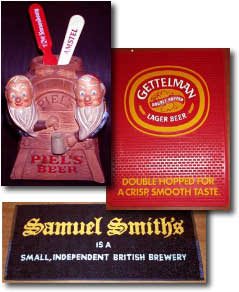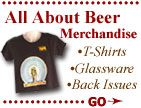
| ||||
| AAB Departments |
| ...Beer Features |
| ...Beer Talk |
| ...Pull Up A Stool! |
| ...What's Brewing |
| ...Beer Travelers |
| ...Stylistically Speaking |
| ...Beer & Food |
| ...Homebrewing |
| ...Collectibles |
| ...Marketplace |
| Beer Lovers' Resources |
| ...World Beer Festival |
| ...Brew Cruise Info |
| ...AAB Merchandise |
| ...AAB Bookstore |
| ...Beer Links |
| About the Magazine |
| ...Subscription Info |
| ...Retail the Magazine |
| ...Wholesaler Program |
| ...Advertising Info |
| ...Contact AAB |

|
All About Beer Magazine
Volume 23 Number 6
January 2003
Wiping the Scrape Clean
by Dave Gausepohl
 Foam has been marketed as a bad pour in most taverns. In this country we have the idea that the barkeep is trying to rip us off by pouring a beer with too much head, the equivalent of the butcher with his thumb on the scale. Truth be told, it is good for beer to foam. The foam allows some of the carbon dioxide to escape before you drink the beer.
Foam has been marketed as a bad pour in most taverns. In this country we have the idea that the barkeep is trying to rip us off by pouring a beer with too much head, the equivalent of the butcher with his thumb on the scale. Truth be told, it is good for beer to foam. The foam allows some of the carbon dioxide to escape before you drink the beer.
Foam, after all, is just a form of beer in suspension. Notice how an American light lager has a bright white color to the foam, and stouts or porters have a deep brown or tan color to their foam. Foam is about 20 percent beer mixed with gas.
Nevertheless, as a matter of principal, if you pour more than two fingers worth of foam, you can expect your customers to bellyache. This fact created the need for foam scrapers, bar towels, drip mats and other ways to sponge off your friends. Over the years, these items to assist in the perfect pour have become quite collectable.
The most notable has to be the foam scraper. This unique device looks like a tongue depressor. Its purpose is simple: after the bartender poured the beer, he would use it to swipe the foam level with the rim of the glass.
These were simple tools, but the breweries came up with various ways to enhance them. Materials like wood, metal and plastic, along with different colors and the addition of brewery logos and slogans set foam scrapers apart. Some were even made of mother of pearl. Later versions were curved liked the blade of a bulldozer.
The breweries also offered different types of containers to hold the scraper when it was not in use, which ironically led to the little tool's downfall. The caddies built to hold the scrapers were often ornamental and distinctive. They were made of plastic, glass, metal and ceramic materials. They were also usually very visual and three dimensional in their designs. Unfortunately, they did not drain and were difficult to clean. As time went on, the containers and their resident scrapers quickly became breeding grounds for all kinds of mold and bacteria. When the patron began crying about his beer having too much foam, he ended up with a bad case of real bellyaches for his complaining.
Another bartending tool is the drip mat, a rubber pad with raised dots to hold the glass up and allow the spillage to run away or the freshly washed glassware to air dry. These mats were sometimes long and ran lengthwise on the bar. Other times, they were wide and placed next to the taps waiting for the full beers to gather or the clean glass to get its fill of beer.
Another great collectable that has helped the bar to shine is the pub towel. These absorbent little terry cloth tools have helped many a barkeep clean up in the beer business.
Originally, this was a tool seen mostly in the British Isles. The brand name of the beer was woven into the cloth and was visible on either side of the towel. The freshly poured pints rested here before being passed on to the thirsty patron. This durable towel helped contain the spillage and keep the place clean. A simple rinse and a wring, and it was ready for another round of customers.
----------------------------
Beer Dave Gausepohl has collected breweriana since 1974 and has a personal collection of over 400,000 items. He has visited over 1,000 breweries and tasted well over 10,000 different brews from the world over.








